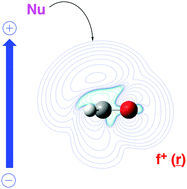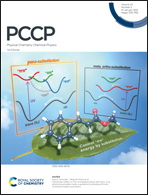Extending conceptual DFT to include additional variables: oriented external electric field†
Abstract
The extension of the E = E[N, v] functional for exploring chemical reactivity in a conceptual DFT context to include external electric fields is discussed. Concentrating on the case of a homogeneous field the corresponding response functions are identified and integrated, together with the conventional response functions such as permanent dipole moment and polarizability, in an extended response function tree associated with the E = E[N, v, ε] functional. In a case study on the dihalogens F2, Cl2, Br2, I2 the sensitivity of condensed atomic charges (∂q/∂ε) is linked to the polarizability of the halogen atoms. The non-integrated (∂ρ(r)/∂ε) response function, directly related to the field induced density change, is at the basis of these features. It reveals symmetry breaking for a perpendicular field, not detectable in its atom condensed counterpart, and accounts for the induced dipole moment directly related to the molecular polarizability. The much higher sensitivity of the electronic chemical potential/electronegativity as compared to the chemical hardness is highlighted. The response of the condensed Fukui functions to a parallel electric field increases when going down in the periodic table and is interpreted in terms of the extension of the outer contours in the non-condensed Fukui function. In the case of a perpendicular field the (∂f(r)/∂ε) response function hints at stereoselectivity with a preferential side of attack which is not retrieved in its condensed form. In an application the nucleophilic attack on the carbonyl group in H2CO is discussed. Similar to the dihalogens, stereoselectivity is displayed in the Fukui function for nucleophilic attack (f+) in the case of a perpendicular electric field, and opposite to the one that would arise based on the induced density. Disentangling the expression for the evolution of the Fukui function in the presence of an electric field reveals that this difference can be traced back to local differences in the polarization or induced density between the anionic and the neutral system. This difference may be exploited, e.g. for an appropriately substituted H2CO, to generate enantioselectivity.

- This article is part of the themed collection: 2021 PCCP HOT Articles


 Please wait while we load your content...
Please wait while we load your content...